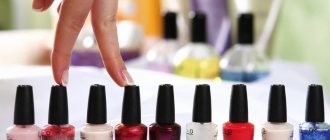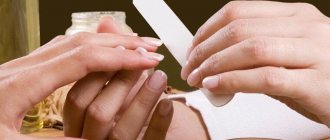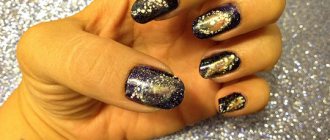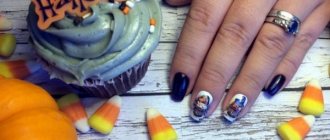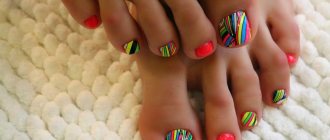The land of the rising sun - Japan - has always been considered the trendsetter of “strange” fashion, because everything here looks completely unusual, from the general cultural style to hairstyles, makeup and manicure style. Identical sensations can be obtained after getting acquainted with other cultures of eastern countries, for example, Turkey or Asia. This is why nail designs in Japanese and oriental styles are so attractive to lovers of extraordinary solutions and experiments with their own image.
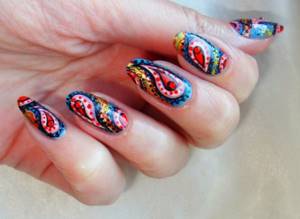
The limitlessness and uniqueness of such nail art amazes with the variety of ideas, and an ordinary manicure for oriental beauties is noticeably different from the design options popular in the CIS countries or Europe. At the same time, any designer will tell you with confidence that after a close acquaintance with such a mysterious manicure, you will definitely collect a lot of ideas to complement this or that image, and you will definitely want to repeat the experiment.
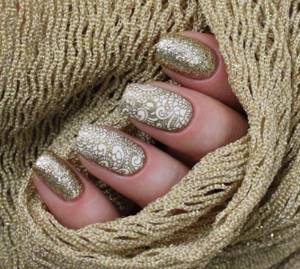
What is the peculiarity of oriental nail design and what ideas for its design are considered the most popular, you will learn further.
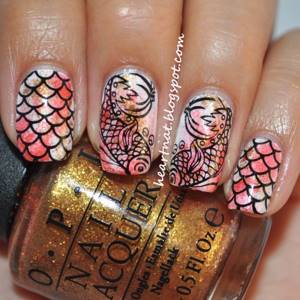
Fashion trends in manicure in Japanese and oriental style
As we have already said, a manicure in a Japanese or oriental style is significantly different from the design options we are accustomed to, and this is primarily manifested in the abundance of bright colors and patterns and ornate patterns characteristic of a particular culture.

Oriental patterns can be made on nails of any length. The only exception is the recommended nail shape for Japanese manicure, which we will discuss in more detail below. Particular preference is given to artistic painting or ready-made sliders that can clearly emphasize the chosen direction. Also, do not forget about the bright decor, because various decorations are an integral part of oriental beauty.
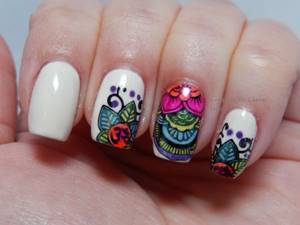
Advantages and disadvantages
Moon manicure is a coloring method that is performed without completely filling the nail plate with one color, leaving a moon-shaped space on it unpainted or filled with a different color. Most often this is the area near the cuticle.
Advantages:
- ease of implementation;
- suitable for nails of any shape, does not spoil the image;
- easy to make using a stencil;
- fits any style of clothing, does not look vulgar;
- does not require major changes during correction.
Flaws:
- Looks bad on unkempt, diseased nails (pigmentation problems);
- Requires concentration and careful movements if done without a stencil.
This design has more advantages than disadvantages, because it can be made in any color scheme.
How to choose a nail shape for Japanese nail design
The choice of the shape and length of nails for Japanese manicure is a separate topic for discussion, because fashionistas of the land of the rising sun have their own concept of “beauty”. The usual square, oval or almond-shaped nails in other countries are not at all impressive to them, unless, of course, you are talking about super-long false nails.

Natural nails typically have a slightly pointed tip and a very short length. Therefore, if you want to exactly replicate one of the Japanese designs, you will have to choose from the options offered.

Oriental style manicure - basic palette of shades
“The East is a delicate matter,” so the choice of varnish shades for creating an oriental-themed manicure should not be taken lightly. In particular, Japanese fashionistas often use classic black, red, white and blue colors in their outfits, which combine perfectly with each other and look harmonious separately.

Also worth noting is the pastel palette, translucent light shades and the smoky color popular in Eastern countries - a dull, calm shade. As for Turkish or Asian culture, dark and bright shades predominate here, for example, burgundy, emerald, sapphire or burgundy. And also classic white, black, red, silver and gold.

Japanese style marigolds with flowers and sakura
All Japanese are madly fond of floristry, and in Tokyo there is a wonderful flower garden where you can see thousands of different flowers and plants. Therefore, Japanese nail designs often contain images of hydrangea, saffron, lotus or wisteria. In this case, special preference is given to sakura flowers. Drawings can decorate a simple or translucent base, combine with French and any other techniques, decorate each nail or serve as an accent.
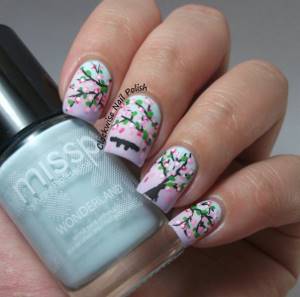
Breathable nail polish: halal or not?
So why was there so much fuss and controversy? The fact is that Islam obliges any Muslim (both man and woman) to perform prayer five times a day, which is certainly preceded by at least a small ritual ablution (also called wudu or taharat), which involves rinsing the mouth, washing the nose, washing face, arms to elbows and feet to ankles, wiping parts of the hair on the head with wet hands. Including, when washing your hands, water should also wash your nails. If ablution is performed incorrectly, in violation of the rules, then it is considered invalid, as is the prayer that follows it.
In connection with these rules, manicure for Muslim women becomes a big hassle. After all, varnish applied to the nails prevents the surface of the nails from being washed with water, and accordingly, it violates Taharat and invalidates the subsequent prayer. Therefore, in order to maintain the validity of wudhu, women are forced to remove the nail polish before performing it. Doing this at least once a day, you will agree, is quite troublesome, and five times a day is completely beyond reason. Some women apply nail polish daily (or on days when such a desire arises) in the evening, after the last prayer, in order to go out somewhere in public, and remove it before ablution before the morning prayer of the next day. In practice, most Muslim women use nail polish only on menstruation days, when a woman is generally exempt from the need to perform prayer. Many people refuse manicure polish altogether. Of course, there are girls and women who break all these rules and wear nail polish constantly, including performing ablution with it. But let's leave this to their religious conscience. I suppose even without us they have a lot of detractors.
For the sake of curiosity, I note that Islam does not prohibit wearing nail polish during the prayer itself, in which case it will be valid. But if varnish was present on the nails during wudu, both wudu and the prayer after it will be invalid. Also, Islamic rules do not generally prohibit the use of manicure polish. Islam only prohibits a woman from attracting the attention of strangers to her appearance. Therefore, in principle, many Muslims consider a manicure of discreet, soft shades acceptable for a woman, even in public. A bright manicure is allowed for her when she is at home, with her husband or close relatives.
But let's return to the rules of ablution. With the advent of “breathable” nail polishes, Muslim women now have the opportunity to maintain their Taharat without removing the polish from their nails. That is why Inglot O2M nail polish, which allows water and air to pass through, created such a sensation. After all, theoretically, if water penetrates the nail through a layer of varnish, the nail is washed and cleansed, which means that the rule of ablution and ritual purity is fulfilled. Hooray! Muslim women rejoice! Now you can be both well-groomed and fashionable without compromising your communication with Allah.
And here, as usual, many “buts” arose, which gave rise to such lively discussions about the halal nature of nail polish. Firstly, it turns out that Inglot's water-permeable O2M doesn't do very well. Experiments carried out by many people interested in the issue have shown that varnish applied to a paper napkin either does not allow a drop of liquid to pass through,
either passes after a long time, or allows liquid to pass only as a result of thoroughly rubbing it into the surface of the hardened varnish. In short, the water permeability of this varnish was questioned. Secondly, questions were raised regarding the interpretation of religious texts regulating the rules of ablution. Some of the religious leaders stated that it was sufficient simply for water to penetrate the surface of the nail, others said that water should not only flow to the nail, but also return back, taking with it contaminants (and the manufacturer of the varnish did not promise this), while others argued that water must certainly wash the surface of the nail, i.e. approach it, make a forward movement along it and move away from it. Thus, some varnish was completely “rejected” in terms of halal, even if it passed all permeability tests with a positive result. In general, everything is difficult!
As a result, today every Muslim woman decides for herself, in accordance with her personal opinion and the opinion accepted in her Islamic environment, whether it is possible to use such a varnish and at the same time maintain the correctness of ablution. Somewhere “breathable” varnishes are considered acceptable, somewhere they violate Taharat, somewhere they even talk about the haram (forbidden) of any manicure and makeup.
I think, for reasons of reasonableness (and Islam is a very reasonable religion), some of the “breathable” nail polishes could well be considered halal. Those of them that really pass water through themselves well. And there are such! I will not give specific arguments now. In defense of my opinion, I will only say that halal certificates have been issued to “breathable” nail polishes from some manufacturers. And they were issued by quite serious Islamic associations, among whose members there are authoritative Muslim figures. And these varnishes really do pass water well, which is confirmed by tests not only of manufacturers and associations issuing certificates, but also by the experiences of the users themselves. If you wish, you can purchase these varnishes and independently conduct experiments with the passage of water using them, using the simplest equipment - absorbent paper napkins.
Japanese manicure with hieroglyphs
Manicure ideas with hieroglyphs are a direct confirmation of the fact that oriental themes are increasingly attracting modern fashionistas. It should be noted that for many, such designs on nails are not just a beautiful image. Women thoroughly study Japanese signs and symbols and attach deep meaning to their image.
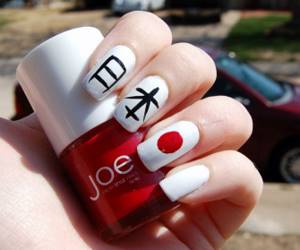
For example, the character 富 (tomi) means wealth. 吉 (kichi) means luck, 幸 (sachi) means happiness, and 愛 (ai) means love. Japanese symbols are usually applied in black using artistic inks, cursors or embossing and can additionally be combined with cherry blossoms, geisha images, yin-yang symbols and other Japanese-style designs.
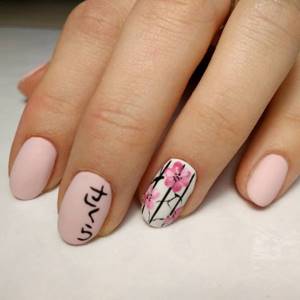
Necessary materials
Depending on the chosen design you will need:
- main and second varnish color;
- manicure set;
- BAF – file for grinding;
- plate degreasing agent;
- fixative;
- wooden stick;
- hand cream;
- stencils, foil or brush;
- UV lamp;
- cotton pad or swab.
If a manicure with holes is being done at home for the first time, then it is better to use stencils and limit yourself to two pastel-colored polishes.
Nail design in Japanese theme with anime
Despite the fact that anime art in our circles is not as popular as in Japan, all kinds of images of cartoon and comic characters with huge eyes or images of unusual fantastic animals are an integral part of Japanese culture and are often used to create trendy nail designs. Such anime drawings are made using artistic painting. However, if you try, you may find sliders with similar images. This design looks unusually bright and expressive.
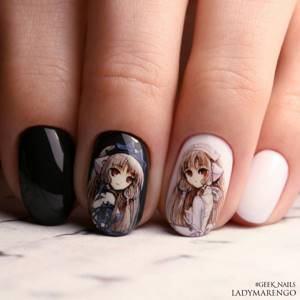
Oriental manicure with Turkish motifs
Nail designs with Turkish motifs are distinguished by their stunning beauty and originality; it is often simply impossible to take your eyes off the intricate patterns in such a theme. To perform this manicure, bright and rich shades are used. As for the choice of technique or drawing methods, there are no strict restrictions or rules. The emphasis is mainly on the pattern itself, which, at the request of the fashionista, can be combined with any base, gold or silver decor. The most popular and simplest in this case is the image with the original name “Turkish Cucumber”.

Techniques for drawing roses
The main types of strokes in Chinese painting Masters distinguish not many strokes and they are easy to remember:
- Smooth surface - created without lifting the brush from the surface;
- openwork - the stroke is uneven because the brush works up and down;
- semi-openwork - loops are threaded;
- wave - to create this stroke you need to make a slight twisting movement with the brush while drawing.

Chinese nail painting is not only fashionable and stylish, it is also sophisticated and elegant. Not every girl can boast of such a manicure, since its implementation will require a lot of time.
But if you manage to overcome your impatience, the result will simply stun you! In addition, once you are immersed in the atmosphere of this craft, you will be able to find peace and tranquility in this work.
Painting for beginners video
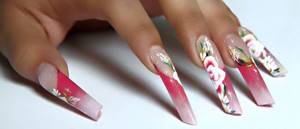
Of course, it is impossible to wear such a work of art every day. It would be better if this type of manicure becomes a special, festive option for you, the creation of which you will approach with special trepidation.
And we can assure you that your work will definitely not go unnoticed; Chinese painting will not only attract attention, but will also indicate your refined, incomparable taste.




